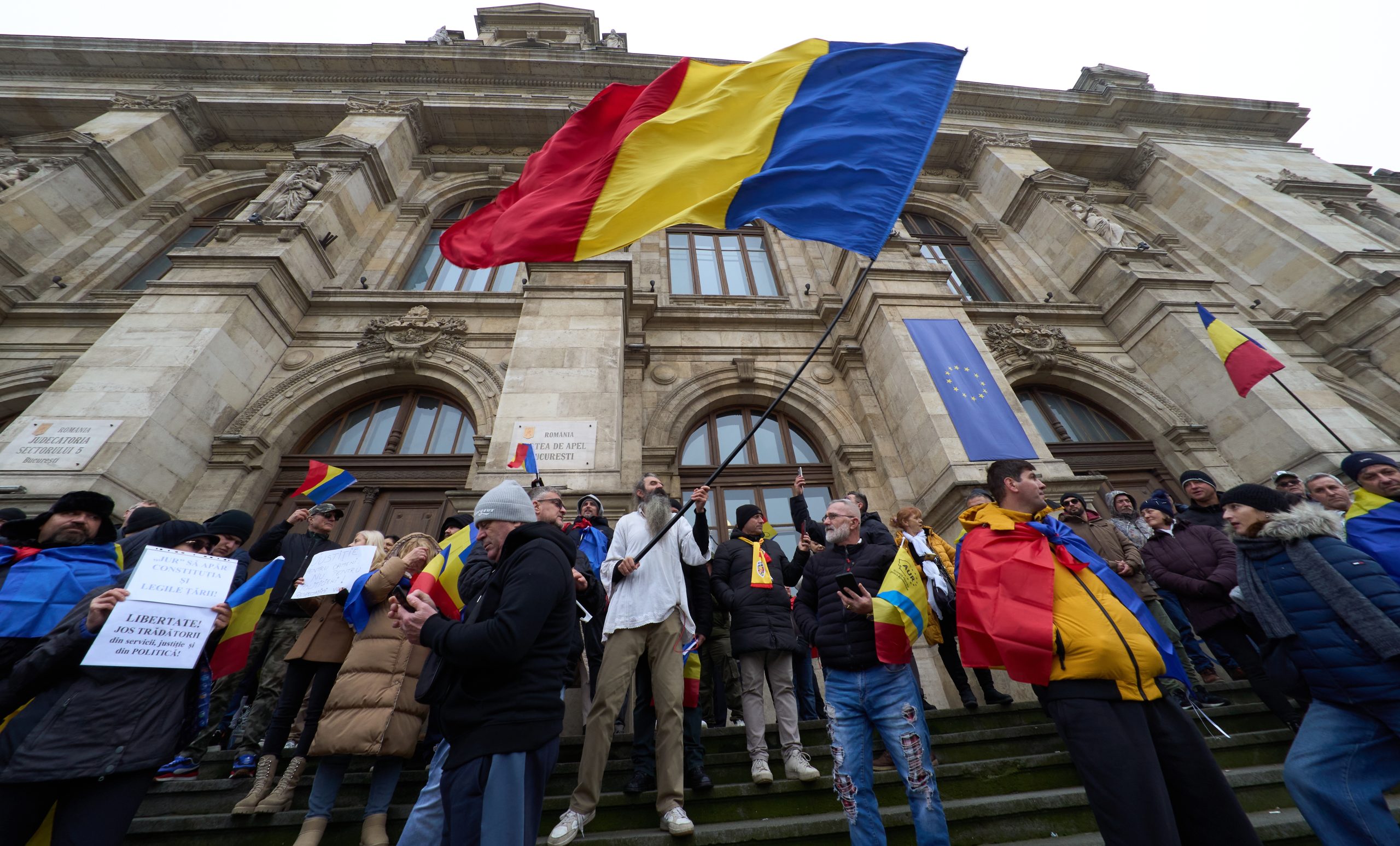Photo: Adela Leiweberova 2025-02-03
Photo: Adela Leiweberova 2025-02-03
TikTok has stirred the pot in the political arena in the United States and Europe alike. From the ongoing process with the ban in the US, which is currently on hold, to the Chinese platform’s interference in European elections. In this interview, Josef Šlerka unpacks the intricacies of TikTok’s algorithm and its implications for political content. He is an expert on issues of disinformation and conspiracy theories, working as a data analyst, reporter at our partners Investigace.cz and the head of the Department of New Media Studies at Charles University in Prague.
Let’s start with the basics: can you provide an overview of what we know about the TikTok algorithm, particularly regarding political content?
We need to address two aspects here. First, there’s the TikTok algorithm itself. Second, there are the rules governing political content, which are somewhat distinct topics. Starting with political content, TikTok has a straightforward policy—it prohibits political advertising. TikTok presents this as an example of responsible platform governance. Essentially, political entities are not allowed to pay for ads on TikTok, and the platform formally ensures that no abuses occur during elections. To support this, TikTok has specific teams dedicated to monitoring election-related content. These teams work to ensure that election-related posts are appropriately labeled. TikTok applies this labeling approach even to sensitive topics like the war in Ukraine. The question remains: how effective is it in achieving these goals? While there’s an effort at a formal level, the practical success of these initiatives is debatable.
Now let’s talk about the algorithm. TikTok isn’t a traditional social network anymore—it’s more like an algorithmic television platform. What does this mean? In the past, content on social networks was shaped by what you wanted to see and the friends you followed. Essentially, your preferences and your network curated the content for you. TikTok, however, has introduced a fundamental shift. Its algorithm tracks your interactions closely—how long you watch a video, whether you like, comment, or choose not to give a like. Based on this data, TikTok delivers content you might enjoy, but much of this content isn’t from your friends or the accounts you follow. In fact, it’s estimated that 80% of the content you see on TikTok comes from strangers or organizations you’ve never interacted with. While TikTok hasn’t disclosed the exact workings of its algorithm, its success is undeniable, as users tend to spend significantly more time there, compared to other platforms.

Romanian far-right supporters protest in Bucharest. Source: Shutterstock
Romania provides an illustrative example of TikTok’s popularity, where TikTok rivals Facebook in user base size, but research shows people spend far more time on TikTok than on Facebook. Users are also more engaged—they interact more and create more content. This activity has historical roots, as TikTok evolved from Musical.ly, a platform originally popular for karaoke-style videos. While these origins are relevant, the key takeaway is that TikTok’s content is primarily driven by algorithms, not by your friends.
I recently listened to the podcast on investigace.cz where you were a guest, and I was intrigued by your comparison between video reach and follower count. You pointed out that the number of followers doesn’t necessarily correlate with the reach of a video. Could you elaborate?
This disparity stems directly from the way TikTok’s algorithms work. Unlike traditional platforms, where the reach of content largely depends on follower count, TikTok operates differently. If you upload a video with no followers, it might still receive 100 views almost instantly, even if it’s unremarkable. The algorithm does this to gauge user interest—if some viewers engage with it, TikTok amplifies its reach. This approach creates a significant disconnect between follower count and the views individual videos achieve.
Let’s move to the current situation in the United States, particularly the paused TikTok ban. Since the inauguration of president Trump, a 75-day lift of the ban began. The controversy seems to revolve around its Chinese ownership and its partial shift under the control of the United States. Do you think there’s a real chance the U.S. will get any part of the ownership over TikTok’s operations?
You’re right—the issue isn’t about TikTok distributing criminal content in the U.S. The core concern is its massive collection of user data, which is owned by a Chinese company. To address this, TikTok has been offered an option: sell its Chinese operations so that user data is controlled by a U.S.-based company under U.S. jurisdiction. This debate isn’t about content moderation but rather whether the U.S. is comfortable with China controlling such sensitive data.
Has there been any discussion about American influence on TikTok’s algorithm or new content regulation rules?
Not really. What we’ve seen instead is a long-standing concern about Chinese ownership. While the U.S. government initially pushed for TikTok’s network shutdown, the newly appointed president Trump extended the timeline for finding a resolution and lifted the ban.
Historically, there were proposals for creating a U.S. subsidiary of TikTok, where American shareholders would have significant stakes. Given how many American investors already hold shares, this could shift influence below the voting threshold of Chinese shareholders.
To compare this with other platforms used in the U.S., there’s a history of concerns around data ownership. Do you think the U.S.’s focus on TikTok stems mainly from political interests?
I believe so, yes. In the U.S., access to personal data is relatively open compared to the EU, where data protection is foundational to modern policy. In America, the debate is framed more as a national security issue. From this perspective, the U.S. doesn’t want an entity owned by a foreign power—especially China—controlling such extensive data on American users. And specifically in the case of China, even if it’s not worded that way, there are some laws that mandate that Chinese companies give up or cooperate with Chinese intelligence if necessary, and also prohibit them from reporting it.
During TikTok’s brief shutdown in the U.S., many users switched to another Chinese-owned platform, RedNote, which according to some reporting suggests poses even greater security risks. What’s your take on this?
This illustrates the problem with banning a single platform without addressing the underlying issue—data ownership by foreign powers. If users move to RedNote, it’s likely we’ll see similar legislation targeting that platform as well. The root issue remains unresolved.
The TikTok ban in the U.S. was also criticized as a violation of free speech, that was one of the users’ arguments at least. How do you view this argument, and does it differ between the U.S. and Europe?
The U.S. and Europe approach free speech very differently. In America, the impact of speech—including hate speech—is often evaluated. In Europe, historical experiences with World War II and communist regimes have led to stricter limits on certain types of expression, regardless of their impact. For example, Holocaust denial is illegal in Germany and other European countries.
In the U.S., it was about national security issues and ownership of American’s data. That is, the question of free speech is not at all on the table. Tik Tok had the only option for their marketing to handle it— by making it a free speech issue. But that’s just a marketing ploy on its part.

Josef Šlerka, expert on disinformation and conspiracy theories. Photo: Adela Leiweberova
Shifting to Europe, do you think recent events around TikTok will influence elections in countries like Germany, the Czech Republic, and Poland? It has been a facilitating platform for far-right extremists and conspiracy theories, more recently, the influence network on Romania’s TikTok helped a far-right presidential candidate Călin Georgescu win the first round of the election, which was eventually annulled. Declassified Romanian intelligence reports exposed election manipulation on social media—illegal campaign financing on TikTok, cyber-attacks and Russian interference.
The Romanian case has already had an impact across the EU. For instance, TikTok has been ordered not to delete campaign-related data during elections. This shows that the platform is under closer scrutiny. Politicians who previously dismissed TikTok as a platform for teenagers are now paying attention. As Romania has shown, TikTok is no longer a minor platform but a major social network.
The EU’s Digital Services Act has introduced a system of feedback loops and procedures for addressing issues with platforms like TikTok. Governments can’t just decide to ban TikTok overnight—there are steps like recommendations for improvement, appeals, and a limited four-week shutdown period. If an unjustified decision is made, TikTok could even claim damages.
Are politicians adapting their behavior on TikTok in the lead-up to elections in these countries?
This has to do with the type of content preferred on TikTok. Your videos have to be natural, have a certain “vibe”—videos that feel authentic and engaging. This creates challenges for many European politicians, who often lack the charisma or style that resonates on TikTok. Populist politicians, however, tend to excel at this type of communication. While traditional politicians sometimes attempt to emulate this style, their efforts often come across as awkward. After Romania, we will see more concentration, both from the democratic parties, but also from those parties that are right-wing, extremist right-wing, populist. And of course, we’re going to see some efforts to manipulate that TikTok algorithm in favor of some political entity.
From what you say, it also sounds like populists simply remain populists and have just found a new platform. Or is it the platform that is changing political communication and campaigning on social media?
I think both are true at the same time. Many of these politicians have a natural disposition to do this, but at the same time there are politicians who have gone very much against the current. In the Czech Republic we have the phenomenon of the former Finance Minister Anna Schillerová, who stuck to the youth content on TikTok. We can see her doing dances, dressing up in different clothes, she actually chooses that form of communication.
In a way there is some TikTok-ization of politics. That is, there’s a part of speeches that are already shaped to make good TikTok videos. That’s how some American political commentators are assessing Donald Trump’s inauguration speech. They say it was a speech that was put together to make it easy to cut into short videos to make good content.
Finally, could you share some insights from your work on the Firehose of Falsehoods project, particularly related to TikTok?
We’ve been studying TikTok for about a year as part of this three-year project. One of the key findings is how effectively far-right groups use TikTok to spread lies, panic, and hatred. Romanian colleagues demonstrated how easy it is to amplify harmful content without penalties. In some cases, TikTok has even amplified such content further.
It turned out that in a lot of those countries, TikTok was also a channel through which Russian propaganda was coming into Europe. My colleagues from Ukraine, even though they weren’t a part of this project, could tell a lot of stories about TikTok’s role in the conflict between Russia and Ukraine. So it’s a platform that is much more in line with propaganda, conspiracies, misinformation and so on.
How does TikTok compare to platforms like Instagram in this context?
TikTok has captured the younger and younger-middle generation, while Instagram remains a stable but broader platform. But Instagram actually, like Facebook, tends to enclose those people in broader bubbles, and there’s significantly less hate content there. We’ll see what changes after Zuckerberg announced that Facebook is going to behave differently, but of course no one can know.
Another thing is the transparency of the ads. Actually, the fact that those political ads are not enabled on TikTok is a little bit of a ploy on TikTok’s part to not have to deal with that issue, which Meta and other companies have to.
Subscribe to “Goulash”, our newsletter with original scoops and the best investigative journalism from Central Europe, written by Szabolcs Panyi. Get it in your inbox every second Thursday!
Tamara is a journalist from Slovakia, currently based in the Netherlands. Besides VSquare, she writes for The European Correspondent.







